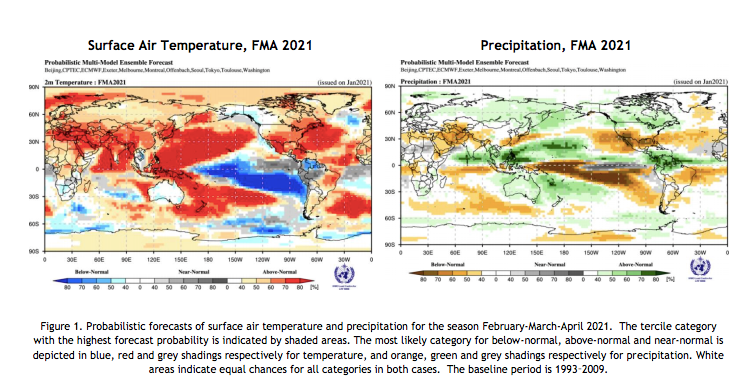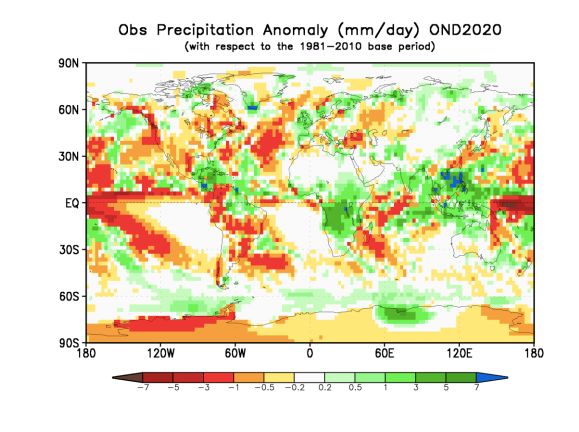La Niña has peaked, but impacts continue
The 2020-2021 La Niña event has passed its peak, but impacts on temperatures, precipitation and storm patterns continue, according to a new update from the World Meteorological Organization (WMO). Despite the general cooling influence of La Niña events, land temperatures are expected to be above-normal for most parts of the globe in February-April 2021. La Niña appears to have peaked in October-November as a moderate strength event. There is a 65% likelihood that it will persist during February-April, with a 70% chance that the tropical Pacific will return to ENSO-neutral conditions by the April-June 2021 season, according to WMO’s El Niño-La Niña Update.

The 2020-2021 La Niña event has passed its peak, but impacts on temperatures, precipitation and storm patterns continue, according to a new update from the World Meteorological Organization (WMO). Despite the general cooling influence of La Niña events, land temperatures are expected to be above-normal for most parts of the globe in February-April 2021.
La Niña appears to have peaked in October-November as a moderate strength event. There is a 65% likelihood that it will persist during February-April, with a 70% chance that the tropical Pacific will return to ENSO-neutral conditions by the April-June 2021 season, according to WMO’s El Niño-La Niña Update.
La Niña refers to the large-scale cooling of the ocean surface temperatures in the central and eastern equatorial Pacific Ocean, coupled with changes in the tropical atmospheric circulation, namely winds, pressure and rainfall. It usually has the opposite impacts on weather and climate as El Niño, which is the warm phase of the so-called El Niño Southern Oscillation.
“El Niño and La Niña are major drivers of the Earth’s climate system. But all naturally occurring climate events now take place in the context of human-induced climate change, which is increasing global temperatures, exacerbating extreme weather, impacting seasonal rainfall patterns and complicating disaster prevention and management,” said WMO Secretary-General Professor Petteri Taalas.
“Thanks to our ability to predict La Niño and El Niño events in advance, the WMO community has been able to strengthen its support to governments, the United Nations, and stakeholders in climate sensitive sectors to mobilize preparations and save lives,” he said.
La Niña has a temporary global cooling effect. But this was not enough to prevent 2020 from being one of the three warmest years on record. La Niña and El Niño effects on average global temperature are typically strongest in the second year of the event, but it remains to be seen to what extent the current La Niña will influence global temperatures in 2021.
Global Seasonal Climate Update
El Niño and La Niña are major, but not the only, climate drivers. WMO’s Global Seasonal Climate Update (GSCU) incorporates influences of all other major climate drivers such as the North Atlantic Oscillation, the Arctic Oscillation, the Indian Ocean Dipole and other teleconnection patterns.
Seasonal outlooks from the GSCU are used to support planning by the United Nations and other partners in humanitarian and climate-sensitive sectors.
Other than in a few small areas, above-normal land temperatures are expected to dominate everywhere for February-April 2021, according to the latest GSCU, based on forecasts from WMO Global Producing Centers of Long-Range Forecasts.
The highest probabilities of above-normal temperatures occur in western, central and eastern Asia and over the southern half of North America. Above-normal temperatures are also likely over much of the northern high latitudes (except over north-western North America), southern, central and eastern parts of South America, and equatorial and northern regions of Africa.
Below-normal temperatures are more likely for northern South America.

The precipitation outlook for February-April 2021 is consistent with typical La Niña effects on regional climates. These include increased chances of unusually wet conditions over much of South East Asia, Australia and northern South America and islands in Melanesia. Southern Africa may also see above-normal rainfall. There is an increased probability of above-normal precipitation (possibly as snow) over much of the Northern Hemisphere north of about 45°N, where the ongoing negative Arctic Oscillation is influencing weather patterns.
Below-normal precipitation is likely over much of western and central Asia, and along about 30°N in East Asia, as well as parts of the Greater Horn of Africa, parts of Central Africa, sub-tropical latitudes of North America, islands in Polynesia and some parts of south-eastern South America, according to the GSCU.
Regional Impacts
The following analysis is developed using output from the WMO Global Seasonal Climate Update, Regional Climate Outlook Forums, and WMO Regional Climate Centres. While tropical regions have been visibly influenced by La Niña, other regions have been influenced by a mixture of other climate drivers, such as the negative phase of the Arctic Oscillation since December 2020.
East Africa
The important October-December East Africa "short rains" season saw mixed rainfall amounts across the region, with generally drier conditions observed to the north and east, and wetter or nearer normal conditions observed to the south and west of the region, according to the IGAD Climate Prediction and Adaptation Centre (ICPAC). Mixed rainfall patterns are also forecast from February to April.
Southern Africa
Many parts of southern Africa have seen above average rainfall. The significant exception to this is parts of Mozambique and Madagascar which have seen little or no rainfall.
Central Asia
Central Asia generally receives most of its annual rainfall in the first half of the year. Over the last 3 months, many parts of Central Asia have experienced below normal rainfall and the latest GSCU outlook for the next three months indicates that below normal rainfall is again likely.
South East Asia
Large parts of South East Asia have shown a typical La Niña response with significantly above normal rainfall totals over the last few months. This trend is likely to continue, particularly to the east of the region.
Central Pacific Islands
The Islands of the Western Central Pacific, including Papua New Guinea, Kiribati, Tuvalu and Northern Cook Islands have experienced extremely dry conditions over the last few months.
South America (North of the equator)
Rainfall totals over the region as a whole have been very mixed, with the eastern equatorial areas seeing well above normal rainfall totals and the western equatorial areas seeing below normal.
Global seasonal forecasts highlight above-normal rainfall from February through to April for much of this region.
South America (South of the equator)
Much of this region has seen below normal rainfall over the last few months, with Uruguay, central Brazil and northern Argentina seeing significantly below normal rainfall totals. The latest seasonal global seasonal forecast indicates that this trend is likely to continue.

Observed October-November-December 2020 near-surface temperature and precipitation anomalies relative to 1981–2010. (Source: U.S. Climate Prediction Center).
The World Meteorological Organization is the United Nations System’s authoritative voice
on Weather, Climate and Water
The World Meteorological Organization (WMO) is a specialized agency of the United Nations responsible for promoting international cooperation in atmospheric science and meteorology.
WMO monitors weather, climate, and water resources and provides support to its Members in forecasting and disaster mitigation. The organization is committed to advancing scientific knowledge and improving public safety and well-being through its work.
For further information, please contact:
- Clare Nullis WMO media officer cnullis@wmo.int +41 79 709 13 97

